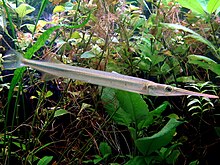
Gars are members of the Lepisosteiformes, an ancient holosteian order of ray-finned fish; fossils from this order are known from the Late Jurassic onwards. The family Lepisosteidae includes seven living species of fish in two genera that inhabit fresh, brackish, and occasionally marine, waters of eastern North America, Central America and the Caribbean islands. Gars have elongated bodies that are heavily armored with ganoid scales, and fronted by similarly elongated jaws filled with long, sharp teeth. Gars are sometimes referred to as "garpike", but are not closely related to pike, which are in the fish family Esocidae. All of the gars are relatively large fish, but the alligator gar is the largest – the alligator gar often grows to a length of over 2 m (6.5 ft) and a weight of over 45 kg (100 lb), and specimens of up to 3 m (9.8 ft) in length have been reported. Unusually, their vascularised swim bladders can function as lungs, and most gars surface periodically to take a gulp of air. Gar flesh is edible and the hard skin and scales of gars are used by humans, but gar eggs are highly toxic.

The tinfoil barb is a tropical Southeast Asian freshwater fish of the family Cyprinidae. This species was originally described as Barbus schwanenfeldii by Pieter Bleeker in 1853, and has also been placed in the genera Barbodes and Puntius. The specific epithet is frequently misspelled schwanefeldii.
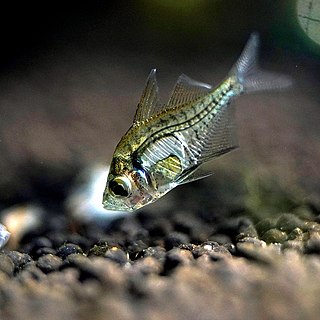
Parambassis ranga, commonly known as the Indian glassy fish, Indian glassy perch, or Indian X-ray fish, is a species of freshwater fish in the Asiatic glassfish family Ambassidae of order Perciformes. It is native to an area of South Asia from Pakistan to Malaysia.
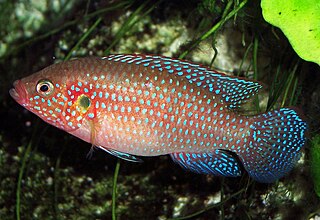
Hemichromis is a genus of fishes from the cichlid family, known in the aquarium trade as jewel cichlids. Jewel cichlids are native to Africa. Within West Africa, Hemichromis species are found in creeks, streams, rivers and lakes with a variety of water qualities including brackish water lagoons.
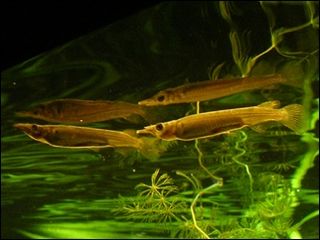
The wrestling halfbeak also known as Malayan halfbeak is a species of viviparous halfbeak native to the fresh and brackish waters of rivers and coastal regions in South-East Asia, in Singapore, Thailand, Indonesia, Thailand, Malaysia, Borneo and Sumatra. It is a small, slender, livebearing fish, with the elongated lower jaw characteristic of its family. The colour of this species varies, depending on where the specimen is found. It is the type species of the genus Dermogenys.

Needlefish or long toms are piscivorous fishes primarily associated with very shallow marine habitats or the surface of the open sea. Some genera include species found in marine, brackish, and freshwater environments, while a few genera are confined to freshwater rivers and streams, including Belonion, Potamorrhaphis, and Xenentodon. Needlefish closely resemble North American freshwater gars in being elongated and having long, narrow jaws filled with sharp teeth, and some species of needlefishes are referred to as gars or garfish despite being only distantly related to the true gars. In fact, the name "garfish" was originally used for the needlefish Belone belone in Europe and only later applied to the North American fishes by European settlers during the 18th century.
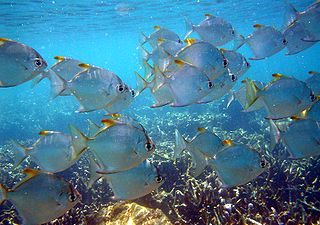
Monodactylidae is a family of perciform bony fish commonly referred to as monos, moonyfishes or fingerfishes. All are strongly laterally compressed with disc-shaped bodies and tall anal and dorsal fins. Unusually for fish, scales occur on their dorsal fins and sometimes on the anal fins. The pelvic fins are small, sometimes vestigial. They are of moderate size, typically around 25 cm in length, and Monodactylus sebae can be taller than it is long, measuring up to 30 cm from the tip of the dorsal fin down to the tip of the anal fin. These long, scaly fins have given them the name "fingerfishes". Most are silvery with yellow and black markings; the juveniles are especially attractive, and most species are popular as aquarium fish.
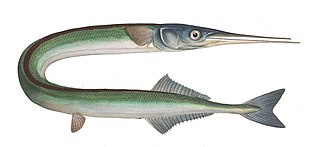
The garfish, also known as the garpike or sea needle, is a pelagic, oceanodromous needlefish found in brackish and marine waters of the Atlantic Ocean, the Pacific Ocean and the Mediterranean, Caribbean, Black, and Baltic Seas.

Fishkeeping is a popular hobby, practiced by aquarists, concerned with keeping fish in a home aquarium or garden pond. There is also a piscicultural fishkeeping industry, as a branch of agriculture.

The Buenos Aires tetra is a tropical fish from South America. It was first observed in the wild in 1907, by Carl H. Eigenmann.

Mikrogeophagus altispinosus is a species of fish endemic to the Amazon River basin in Brazil and Bolivia. The species is part of the family Cichlidae and subfamily Geophaginae. It is a popular aquarium fish, traded under the common names Bolivian butterfly, Bolivian ram, Bolivian ram cichlid, and ruby crown cichlid.

The dwarf pufferfish, also known as the Malabar pufferfish, pea pufferfish or pygmy pufferfish, is a small, freshwater pufferfish endemic to Kerala and southern Karnataka in Southwest India. It is threatened by overfishing for the aquarium trade, and by habitat loss.
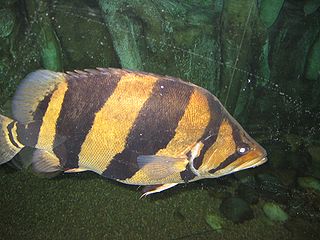
A brackish-water aquarium is an aquarium where the water is brackish (semi-salty). The range of "saltiness" varies greatly, from near freshwater to near marine and is often referred to as specific gravity (SG) or salinity. Brackish water aquaria is a popular specialization within the fishkeeping hobby. Many species of fish traded as freshwater species are actually true brackish species, for example mollies, Florida flagfish, and some cichlids such as chromides and black-chin tilapia. There are also several popular species traded purely as brackish water fish, including monos spp, scats, archerfish, and various species of pufferfish, goby, flatfish, and gar. Generally, aquarists need to maintain a specific gravity of around 1.005 to 1.010 depending on the species being kept, but practically all brackish water fish tolerate variations in salinity well, and some aquarists maintain that regularly fluctuating the salinity in the aquarium actually keeps the fish healthy and free of parasites.

The banded archerfish is a brackish water perciform fish of the archerfish genus Toxotes. It is silvery in colour and has a dorsal fin towards the posterior end. It has distinctive, semi-triangular markings along its sides. It is best known for its ability to spit a jet of water to "shoot down" prey. Larger specimens may be able to hit prey 2 to 3 metres away. The banded archerfish may reach the displaced prey within 50 milliseconds of its hitting the water.

Toxotes chatareus, sometimes known by the common names common archerfish, seven-spot archerfish or largescale archerfish, is a species of perciform fish in the archerfish genus Toxotes.
The kuhli loach is a small eel-like freshwater fish belonging to the loach family (Cobitidae). They originate from Indonesia and the Malay Peninsula. This snake-like creature is very slender and nocturnal. In an aquarium, the kuhli loach can be very reclusive and, when startled, will dart underneath tank ornaments or bury itself, if a fine gravel or sandy substrate is present.
The short-beaked garfish is an uncommon species of needlefish in marine waters of the eastern Atlantic Ocean. This pelagic needlefish is present off the coasts of Ireland, Spain, Portugal, and the United Kingdom, and possibly in the Mediterranean Sea, as well. This species was thought to be the same as the garfish because they share the same waters. The short-beaked garfish matures at 30 cm (12 in) and can grow to a maximum of 65 cm (26 in) while Belone belone can be 95 cm (38 in). Like all needlefish, this one has an elongated body with beak-like jaws that are lined with razor sharp teeth. The short-beaked garfish's lower jaw is longer than the upper. Its body is silvery like most needlefish and has a black stripe running across its lateral line. The dorsal and anal fins are very close to the caudal peduncle. These fish are oviparous. Eggs may be found attached to objects in the water by tendrils on the egg's surface. These spherical eggs are dispersed on the sea floor (demersal). Not much is known about this fish's feeding habits. It likely preys on small oceangoing fish. It has been caught using mackerel. Needlefish tend to be surface fish, so are preyed upon like Atlantic mackerel, European pilchard, sand smelt, etc. The specific name honours Anatolii Nikolaevich Svetovidov (1903-1985) who was an ichthyologist at the Zoological Institute in Saint Petersburg, Russia and a colleague of N.V. Parin.
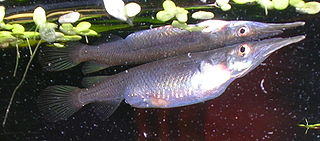
Zenarchopteridae, the viviparous halfbeaks, is a family in the order Beloniformes. The Zenarchopteridae exhibit strong sexual dimorphism, practicing internal fertilisation, and in some cases ovoviviparous or viviparous. The members in the family are mainly found in fresh and brackish water of tropical Asia and New Guinea, but the genus Zenarchopterus also includes marine species from the Indo-Pacific. Several, such as the wrestling halfbeak, have become commonly traded aquarium fish.

Hemichromis letourneuxi is a species of cichlid which is native to West Africa and is popular in the aquarium hobby and it has been introduced to the Caribbean and the south-east United States where it is invasive.
